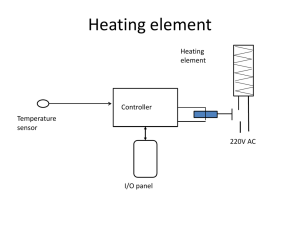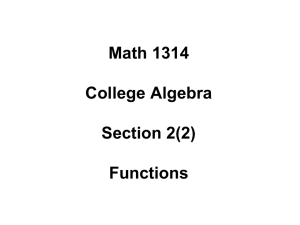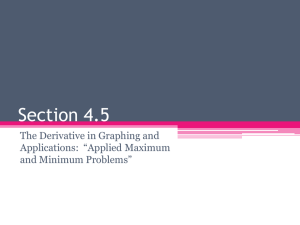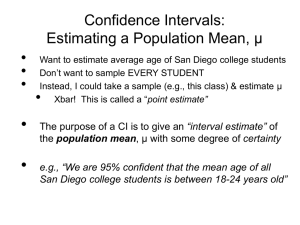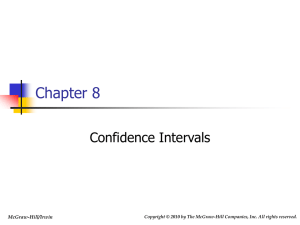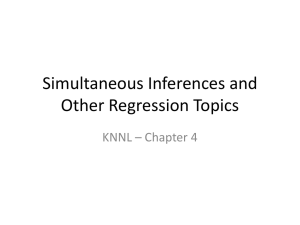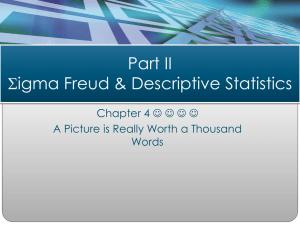chapterP_Sec3
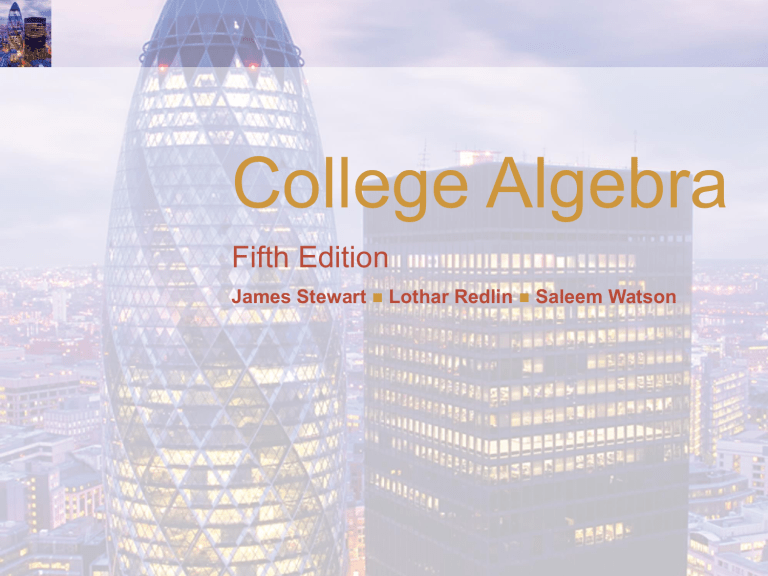
College Algebra
Fifth Edition
James Stewart Lothar Redlin Saleem Watson
P
Prerequisites
P.3
The Real Number Line and Order
The Real Line
Introduction
The real numbers can be represented by points on a line, as shown.
• The positive direction (toward the right) is indicated by an arrow.
Origin
We choose an arbitrary reference point O , called the origin, which corresponds to the real number 0.
Origin
Given any convenient unit of measurement,
• Each positive number x is represented by the point on the line a distance of x units to the right of the origin.
• Each negative number – x is represented by the point x units to the left of the origin.
Coordinate
The number associated with the point P is called:
• The coordinate of P
Real Line
Then, the line is called any of the following:
• Coordinate line
• Real number line
• Real line
Real Line
Often, we identify the point with its coordinate and think of a number as being a point on the real line.
Order on the Real Line
Order of Numbers
The real numbers are ordered.
• We say that a is less than b , and write a < b if b – a is a positive number.
• Geometrically, this means that a lies to the left of b on the number line.
• Equivalently, we can say that b is greater than a , and write b > a .
Symbol a ≤ b
The symbol
a
≤
b
(or
b
≥
a
):
• Means that either a < b or a = b.
• Is read “ a is less than or equal to b .”
Inequalities
For instance, these are true inequalities:
7
7.4
7.5
3
2
2
2
2
E.g. 1 —Graphing Inequalities
On the real line, graph all the numbers x that satisfy the inequality: a) x < 3 b) x ≥ –2
E.g. 1 —Graphing Inequalities
Example (a)
We must graph the real numbers that are smaller than 3.
• Those that lie to the left of 3 on the real line.
E.g. 1 —Graphing Inequalities
Example (a)
The graph is shown here.
Note that the number 3 does not satisfy the inequality.
• So, it is indicated with an open dot on the real line.
E.g. 1 —Graphing Inequalities
Example (b)
We must graph the real numbers that are greater than or equal to
–2.
• Those that lie to the right of –2 on the real line, including the number
–2.
E.g. 1 —Graphing Inequalities
Example (b)
The graph is shown here.
Note that the number
–2
does satisfy the inequality.
• So, it is indicated with a solid dot on the real line.
Sets and Intervals
Sets & Elements
A set is a collection of objects.
• These objects are called the elements of the set.
Sets
If S is a set, the notation
means that a is an element of S.
means that b is not an element of S .
• For example, if Z represents the set of integers, then
Z but π
Z.
Braces
Some sets can be described by listing their elements within braces.
• For instance, the set A that consists of all positive integers less than 7 can be written as:
A = {1, 2, 3, 4, 5, 6}
Set-Builder Notation
We could also write A in set-builder notation as:
A = { x | x is an integer and 0 < x < 7}
• This is read:
“ A is the set of all x such that x is an integer and 0 < x < 7.”
Union of Sets
If S and T are sets, then their union
S T is:
• The set that consists of all elements that are in S or T (or both).
Intersection of Sets
The intersection of S and T is the set
S T consisting of all elements that are in both S and T .
• That is, S T is the common part of S and T .
Empty Set
The empty set, denoted by Ø, is:
• The set that contains no element.
If
E.g. 2 —Union & Intersection of Sets
S = {1, 2, 3, 4, 5}
T = {4, 5, 6, 7}
V = {6, 7, 8} find the sets
S
T , S
T , S
V
E.g. 2 —Union & Intersection of Sets
S
T = {1, 2, 3, 4, 5, 6, 7}
(All elements in S or T )
S
T = {4, 5}
(Elements common to both S and T )
S
V = Ø
( S and V have no elements in common)
Intervals
Certain sets of real numbers occur frequently in calculus and correspond geometrically to line segments.
• These are called intervals.
Open Interval
If a < b , the open interval from a to b consists of all numbers between a and b .
• It is denoted ( a , b ).
Closed Interval
The closed interval from a to b includes the endpoints.
• It is denoted [ a , b ].
Open & Closed Intervals
Using set-builder notation, we can write:
( a , b ) = { x | a < x < b }
[ a , b ] = { x | a ≤ x ≤ b }
Open Intervals
Note that parentheses ( ) in the interval notation and open circles on the graph in this figure indicate that:
• Endpoints are excluded from the interval.
Closed Intervals
Note that square brackets and solid circles in this figure indicate that:
• Endpoints are included.
Intervals
Intervals may also include one endpoint but not the other.
They may also extend infinitely far in one direction or both.
Types of Intervals
The table lists the possible types of intervals.
E.g. 3 —Graphing Intervals
Express each interval in terms of inequalities, and then graph the interval.
a) [ –1, 2) b) [1.5, 4] c) ( –3, ∞)
E.g. 3 —Graphing Intervals
[ –1, 2)
= { x | –1 ≤ x < 2}
Example (a)
E.g. 3 —Graphing Intervals
[1.5, 4]
= { x | 1.5 ≤ x ≤ 4}
Example (b)
E.g. 3 —Graphing Intervals
( –3, ∞)
= { x | –3 < x }
Example (c)
E.g. 4 —Finding Unions & Intersections of Intervals
Graph each set.
(a) (1, 3)
[2, 7]
(b) (1, 3)
[2, 7]
E.g. 4 —Intersection of Intervals
Example (a)
The intersection of two intervals consists of the numbers that are in both intervals.
• Therefore,
(1, 3)
[2, 7]
= { x | 1 < x < 3 and 2 ≤ x ≤ 7}
= { x | 2 ≤ x < 3} = [2, 3)
E.g. 4 —Intersection of Intervals
Example (a)
This set is illustrated here.
E.g. 4 —Union of Intervals
Example (b)
The union of two intervals consists of the numbers that are in either one of the intervals.
• Therefore,
(1, 3)
[2, 7]
= { x | 1 < x < 3 or 2 ≤ x ≤ 7}
= { x | 1 < x ≤ 7}
=(1, 7]
E.g. 4 —Union of Intervals
Example (b)
This set is illustrated here.
Absolute Value and Distance
Absolute Value
The absolute value of a number a , denoted by | a |, is:
• The distance from a to 0 on the real number line.
Distance
Distance is always positive or zero.
So, we have:
• | a | ≥ 0 for every number a
Remembering that – a is positive when a is negative, we have the following definition.
Absolute Value —Definition
If a is a real number, the absolute value of a is: a a if a
0
a if a
0
E.g. 5 —Evaluating Absolute Values a) |3| = 3 b) | –3| = –(–3) = 3 c) |0| = 0 d) | – 1| = – 3
2
⇒
2
– 1 > 0) e) |3 – π | = –(3 – π ) = π – 3
(since 3 < π ⇒ 3 – π < 0)
Properties of Absolute Value
When working with absolute values, we use these properties.
Absolute Value & Distance
What is the distance on the real line between the numbers
–2 and 11?
Absolute Value & Distance
From the figure, we see the distance is 13.
• We arrive at this by finding either:
| 11 – (– 2)| = 13 or |(–2) – 11| = 13
• From this observation, we make the following definition.
Distance Between Points on the Real Line
If a and b are real numbers, then the distance between the points a and b on the real line is: d ( a , b ) = | b – a |
Distance Between Points on the Real Line
From Property 6 of negatives, it follows that:
| b – a | = | a – b |
• This confirms, as we would expect, that the distance from a to b is the same as the distance from b to a .
E.g. 6 —Distance Between Points on the Real Line
The distance between the numbers
–8 and 2 is: d ( a , b ) = | –8 – 2|
= | –10|
= 10
E.g. 6 —Distance Between Points on the Real Line
We can check that calculation geometrically —as shown here.
